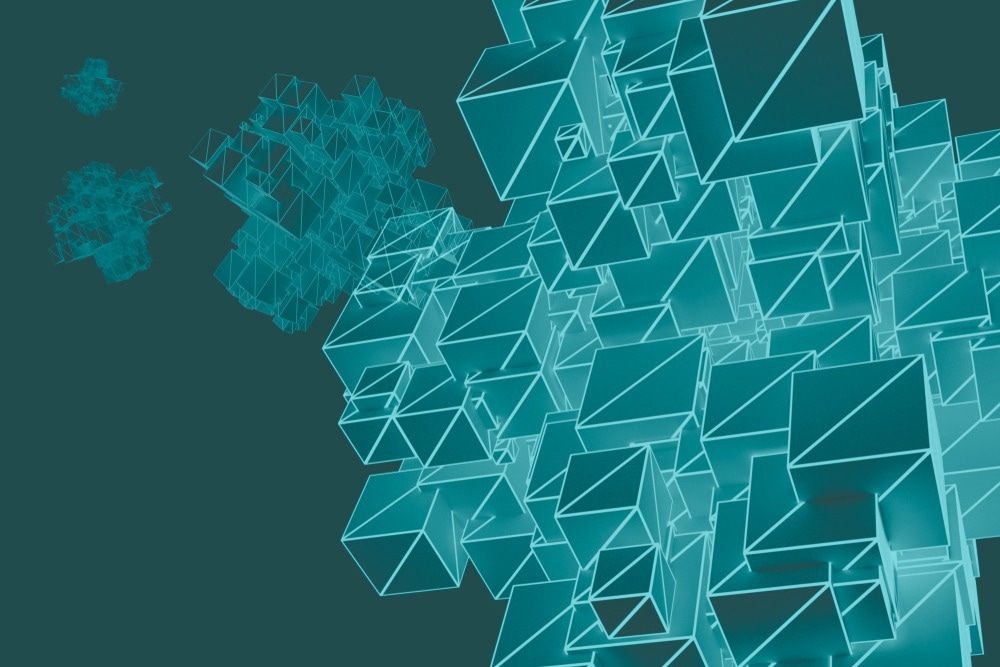Although tracking the morphological changes of nanoparticles in the solution can help tune the functionality of energy generation and storage devices, the lack of experimental methods restrained the visualization of these processes.

Study: Imaging Cu2O nanocube hollowing in solution by quantitative in situ X-ray ptychography. Image Credit: GiroScience/Shutterstock.com
An article published in the journal Nature Communications presented X-ray ptychography as a suitable method that enabled the in situ nanoimaging of nanoparticle formation and hollowing in a solution at 155 degrees Celsius.
X-ray ptychography could simultaneously image the growth of 100 nanocubes with a spatial resolution of 66 nanometers. The quantitative phase images permitted the study of particle thickness. The X-ray ptychography also revealed that the substrate hindered out-of-plane growth.
Additionally, the reduction of copper oxide (Cu2O) to copper (Cu) metal triggered the hollowing of nanocuboids. The critical analysis of X-ray interactions with the liquid sample enabled in-solution imaging of a wide range of reaction conditions.
X-Ray Ptychography
Controlling the morphological and structural evolution of nanoparticles during their synthesis is imperative to achieving desired functionality of energy storage devices and their high performance. However, understanding and tuning the course of morphological changes of nanoparticles is challenging due to the lack of experimental methods. However, insights into in situ dynamics of nanomaterials under suitable temperature and pressure conditions are rare.
Recent efforts in addressing the above problem include utilizing in situ microscopy techniques and liquid-cell transmission electron microscopy (TEM) that provides an atomic scale spatial resolution. These approaches revealed the growth pathways of polyhedral-shaped gold (Au) nanoparticles and shape evolution of Au– palladium (Pd) core-shell nanorods which are temperature dependent.
Ptychography exploits a convolution in Fourier space, between the Fourier transform of a finite illumination function and the coherent Fourier diffraction pattern of the object. X-ray ptychography combines the advantages of raster scanning X-ray microscopy with the more recently developed techniques of coherent diffraction imaging.
The complex transmission function of a sample is reconstructed by X-ray ptychography from different diffraction patterns, by applying the phase-retrieval algorithm. The advantage of X-ray ptychography over scanning transmission microscopy is the spatial resolution which is independent of the beam size. Thus, the resulting images contain sample-induced local phase shift that provides insights into the physical parameters of samples, including the density or thickness of the sample material.
Imaging Cu2O Nanocube in Solution by In Situ X-Ray Ptychography
While spectroscopic methods and X-ray scattering could provide information only at a specific reaction volume, in situ microscopy could provide the pathways that lead to complex and hierarchical materials with varying parameters.
Previously X-ray ptychography was applied in early in situ experiments to image the lithium zirconate nanoparticles in different gas atmospheres at high temperatures. The in situ tomography using X-ray ptychography quantitatively assessed the deformation and strain of a polymer-metal composite under pressure. In addition, X-ray ptychography also allows wavefield calculations in an imaging setup.
In the present study, the X-ray ptychography was applied in solution to visualize the Cu2O nanocube's nucleation and growth, followed by their transformation into hollow copper structures. Thus, demonstrating the possibility of in situ imaging in solution using X-ray ptychography.
Separate two-dimensional (2D) images of particles growing on exit and entrance windows of a reactor using multi-slicing enabled the visualization of the morphological evolution of each nanocube over time. Thus, demonstrating the robustness of X-ray ptychography in direct visualization of complex transformations of shape and size at the nanoscale level.
Furthermore, the thickness of particles was also calculated from quantitative phase images obtained via X-ray ptychography, giving an insight into the three-dimensional (3D) growth and transformation of nanoparticles that facilitated the visualization of different morphologies of nanoparticles that nucleate homogeneously and heterogeneously at different regions of reactor.
Thus, using in situ X-ray ptychography was convenient to obtain rare visual insights into structural transformations of nanomaterials in solution to provide a deep understanding of the origin of their morphology, which is critical to designing functional devices and highly active catalysts.
Conclusion
Overall, the morphological growth of Cu2O nanocuboids and their transformation into hollow structures of Cu were revealed by their direct visualization in a chemical reactor using in situ X-ray ptychography. The quantitative phase images provided an insight into the interaction of nanocuboids with the reactor walls that affected their 3D shape.
On the other hand, the attachment of nanoparticles to the substrate hindered their out-of-plane growth resulting in flat cuboids with an aspect ratio of 0.5. Moreover, the reduction of Cu2O to Cu led to the hollowing of the cube.
Ultimately, studying the effect of the beam (at different photon energies) on the reaction revealed that the hollow metallic structures that denoted the completion of reactions were sensitive to the beam and did not alter the reaction path.
Reference
Grote, L et al. (2022). Imaging Cu2O nanocube hollowing in solution by quantitative in situ X-ray ptychography. Nature Communications, 13. https://www.nature.com/articles/s41467-022-32373-2
Disclaimer: The views expressed here are those of the author expressed in their private capacity and do not necessarily represent the views of AZoM.com Limited T/A AZoNetwork the owner and operator of this website. This disclaimer forms part of the Terms and conditions of use of this website.